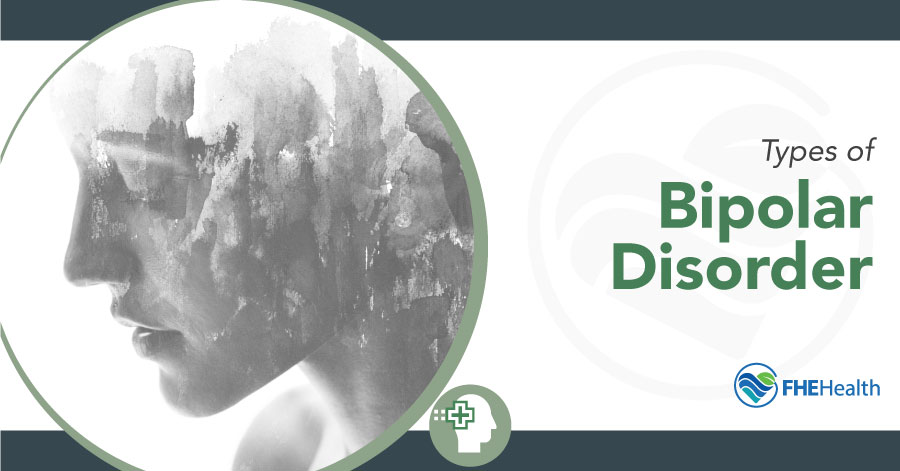
Bipolar disorder is more common among Americans than you might think. As of 2017, 2.8% of the U.S. adult population had some form of bipolar disorder. There are several different states and types of this mood disorder, making every case different.
What Are the Degrees of Bipolar Disorder?
There are five different kinds of bipolar disorder that can be defined and diagnosed. While some are more extreme than others, all forms of bipolar disorder are serious and can impact the way an individual lives and experiences life. Anyone dealing with this condition should seek treatment to manage their symptoms and improve their quality of life.
Bipolar 1
Bipolar 1 is sometimes also called manic depressive disorder. This mood disorder consists of extreme periods of mania followed by periods of major depression. Anyone with a bipolar 1 diagnosis will have a manic episode at least once in their lifetime.
Bipolar 2
Bipolar 2 is a milder form of this mood disorder, with less severe periods of mania followed by depression. Often, bipolar 2 is misdiagnosed as depression because the manic periods may not be obvious. The key differences between type 1 and type 2 bipolar are the less severe bouts of mania and no indication of the person switching between extreme moods. Sometimes, manic episodes for individuals with bipolar 2 disorder can simply appear like they are functioning well.
Bipolar 3 or Cyclothymic Disorder
Bipolar 3 is an unofficial name for a bipolar disorder known more commonly as a cyclothymic disorder. In this disorder, an individual deals with hypomanic and frequently alternating depressed periods. However, the symptoms of depression do not normally last long enough to define a symptom as major depression. The emotional ups and downs of the cyclothymic disorder are not as extreme as the mood shifts that occur in bipolar 1 or 2.
Bipolar 4
Stage 4 bipolar is unique in that it’s identified by manic periods that occur only after an individual has taken antidepressants. This means the initial diagnosis, in this case, is for depression. However, after a time on the medication, a manic period occurs.
Bipolar 5
Bipolar 5 is reserved for individuals who have a family history of bipolar disorder but only display symptoms of depression themselves.
The Stages of Bipolar
There are four key stages of bipolar disorder that an individual goes through. These stages are also categorized as mood episodes. It’s critical to recognize the signs of each stage to be able to seek appropriate treatment and manage the disorder effectively. The stages are:
Acute Mania
Acute mania refers to a stage that’s signified by energetic moods, accelerated activity and irritability. Symptoms of this stage might include less need for sleep, heightened self-esteem, fast-paced thoughts and irresponsible behavior like substance binges, excessive sexual activity or extreme spending.
Mixed Mood Stage
The mixed mood state includes symptoms from both acute mania and depressive mood states. This might look like periods of depression interspersed with overactivity and impulsive behavior and can lead to a tendency towards self-harm or violence.
Major Depressive Episodes
A major depressive episode is defined as experiencing at least five of the following symptoms for two weeks straight, most of the day or every day. These include sadness, exhaustion, having no interest in activities, a change in appetite, too much or too little sleep, agitation, not being able to concentrate, thoughts of death or suicide and feelings of worthlessness or self-loathing.
Maintenance Phase
This is a treatment phase following an episode to help prevent or manage future episodes. A common treatment for bipolar disorder uses a combination of medication and psychotherapy.
Treatment Options for Bipolar Disorder
Several treatments can be used to manage bipolar disorder after a diagnosis. Bipolar disorder is a lifelong mood disorder that requires medication to improve. Three main classes of drugs are used to treat the condition: antipsychotics, mood stabilizers, and antidepressants, though the effectiveness of the latter is somewhat controversial.
These medications are taken in combination with psychotherapy to help people manage bipolar disorder. Psychotherapy is a form of talk therapy that’s designed for the long term (unlike counseling) and involves speaking with a registered psychotherapist to identify and change behavioral patterns and moods through cognitive behavioral therapy. This can be extremely effective when used in combination with medication.
The most common drugs for treating bipolar disorder are lithium carbonate and valproic acid. Lithium carbonate is thought to be most valuable for reducing instances of mania. Valproic acid is a mood stabilizer that helps most in the mixed mood or manic phases of bipolar disorder. Since lithium carbonate is less effective for depressive symptoms, it’s sometimes prescribed in combination with another medication, such as an antidepressant.
Get the Help You Need for Bipolar Disorder
Quite often, people with bipolar disorder who are experiencing hypomania or manic depression don’t realize they have a disorder that requires professional attention. During periods of hypomania, they may enjoy the energy and capitalize on their newfound creativity, or they may sit in the depression and not be able to ask for help. Some individuals are in denial that they’re dealing with a mood disorder or may view mental illness as a weakness and resist treatment for fear of judgment.
It’s vital to remember that bipolar disorder is a real disease that requires treatment just like any physical ailment you’re experiencing. Today, there are plenty of options for managing bipolar 3 and other forms of bipolar disorder, so you can get back to living your life in a healthy way.
At FHE Health, we’re proud to serve Deerfield Beach, Florida, and support adults through high-quality, medically integrated, and personalized treatment plans. Specializing in addictive disorders, the facility also offers treatment for behavioral health disorders like anxiety, depression, PTSD, and mood disorders. If you or a loved one is struggling with bipolar disorder, reach out to us today to explore treatment options and start the path to recovery.






